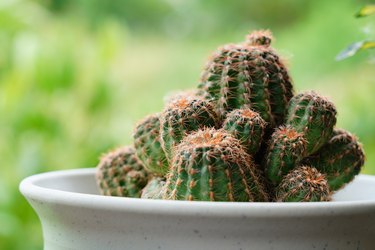
If you notice that your cactus is turning black, don't assume the worst. Black spots on cacti stems and leaves are a common problem with cacti and succulents. These are usually indicative of four underlying issues: either the cactus is over or underwatered, receives too much sun, has a bug infestation or is afflicted with disease or fungi.
Cactus Turning Black: Overwatering
Video of the Day
When a cactus or the leaves on a succulent start to turn black, it could mean that it has been overwatered and the roots are rotting. Generally, the leaves on the bottom will turn black before the leaves farther up. Root rot occurs when plants sit in excess moisture for too long. Check if the black spots on the cactus feel soft. Succulents retain excess water in their leaves, roots and stems, so when there is too much water, the leaves will swell and burst.
Video of the Day
To save your cactus, try cutting away the black sections, then assessing the soil. If the soil is sopping wet, it most likely won't dry enough for the cactus to bounce back. Carefully remove the cactus from the pot and examine the quality of the roots. If they appear to be soft and mushy, then there is not much you can do to save the cactus.
However, if most of the roots still seem in good condition, cut the rotted roots away, and replant the cactus in new, dry soil with good drainage. Begin a watering schedule two to three days after replanting.
Cactus Turning Black: Underwatering
Cacti can go a very long time without water, but that doesn't mean they never need it. If going too long without water, the cactus' roots can collapse and then rot when exposed to water.
To verify that your cactus has not reached that point,you can try using the chopstick method. Insert the chopstick into the soil; if the bottom 2/3 is slightly damp, you can water the cactus.
Cactus Turning Black: Too Much Sun
Sunlight is not one-size-fits-all. While soft cactus types are accustomed to warm weather, hardy cacti are more accustomed to harsh and alpine conditions. There is such a thing as too much, especially when a cactus is trying to get acclimated. Meaning, it's possible your cactus has sunburn.
Before developing full-blown sunburn, the cactus's leaves may first become yellowish from their natural green, then they will start to turn black. Touch the dark spots on the cactus, taking note of the texture. If the cactus feels rough or scarred, the sunburn is severe and there's not much you can do. If the dark spots feel smooth, then the sunburn is just pending and still reversible. If the cactus is planted outside, cover it with a shade cloth during the hottest parts of the day.
If the cactus is potted, move the cactus into the shade and continue to water it, but be careful not to overwater. At this point, the cactus will go into dormancy so it can focus on repairing itself. Once the cactus appears healed, reacclimate it to sunlight by exposing it to the sun for three to four hours a day, adding an hour each day.
Bugs, Disease or Fungi
If the black spots on your cactus resemble freckles, it could be the result of mealybugs, aphids or mites. To remove the pests, cut the affected leaves and wipe the others with rubbing alcohol using a cotton swab.
If your cactus is turning black because of disease or fungi, there are, unfortunately, not many options left to save it. Cut off the infected areas, then sterilize the pruners to avoid spreading the disease to other plants. If you caught the disease early enough, the cactus might be able to bounce back.